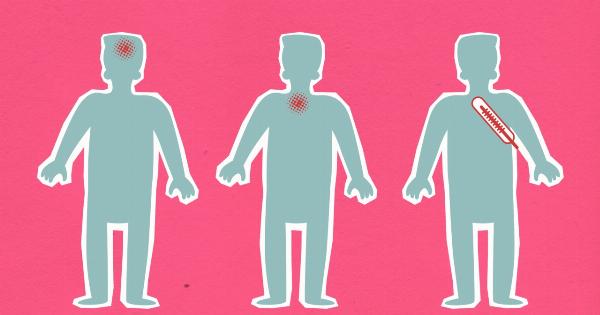Body temperature is a crucial indicator of health and plays a vital role in the proper functioning of our bodies. Understanding the science behind body temperature can help us recognize normal ranges and identify when a fever is present.
In this article, we will delve into the intricacies of body temperature, explore its significance, and explain what happens when a fever occurs.
What is Body Temperature?
Body temperature refers to the internal heat generated by the body as a byproduct of its metabolic processes. It is the result of the balance between heat production and heat loss within the body.
The average normal body temperature tends to vary slightly among individuals but is generally considered to be around 98.6°F (37°C) when measured orally.
How is Body Temperature Regulated?
The hypothalamus, a region in the brain, serves as the body’s internal thermostat.
It regulates body temperature by constantly monitoring the temperature of blood circulating through the brain and receiving input from temperature-sensitive receptors located throughout the body.
When the body temperature deviates from the normal range, the hypothalamus triggers appropriate mechanisms to restore balance.
If the body temperature is too high, it initiates cooling mechanisms, such as sweating and dilation of blood vessels near the skin’s surface, to promote heat dissipation. Conversely, when the body temperature is too low, the hypothalamus triggers mechanisms to generate heat, like shivering and constriction of blood vessels, to help conserve warmth.
Normal Body Temperature Ranges
Although the average normal body temperature is considered to be 98.6°F (37°C), it is essential to note that individual temperatures may vary. Factors such as age, time of day, activity level, and even menstrual cycle can influence body temperature.
The following ranges generally indicate normal body temperature:.
- Oral: 97.6°F – 99.6°F (36.4°C – 37.6°C)
- Axillary (Armpit): 96.6°F – 98.6°F (35.9°C – 37°C)
- Tympanic (Ear): 98.6°F (37°C)
- Rectal: 97.6°F – 99.6°F (36.4°C – 37.6°C)
It is important to use the appropriate method of measurement and account for the normal temperature range associated with each method when assessing body temperature.
What Causes Fever?
A fever, also known as pyrexia, is a temporary increase in body temperature often associated with an illness or infection. It is a defense mechanism employed by our immune system to combat pathogens and prevent their proliferation.
The most common cause of fever is an infection, such as the flu or a bacterial infection, which stimulates the release of chemicals called pyrogens.
Pyrogens act upon the hypothalamus, resetting the internal thermostat to a higher temperature. As a result, the body responds by raising its temperature to create an inhospitable environment for the invading pathogens, aiding the immune response.
This increased body temperature can lead to symptoms like chills, sweating, and fatigue.
Interpreting and Managing Fever
While fevers can be uncomfortable, they are generally a sign that the body is fighting off an infection. It is important to note that a fever is often a symptom rather than a disease itself.
Most fevers are mild and can be managed at home through rest, hydration, and over-the-counter medication such as acetaminophen or ibuprofen.
However, there are instances where a fever may indicate a more serious condition, especially if it persists for an extended period, exceeds 103°F (39.4°C), or is accompanied by severe symptoms.
In such cases, it is advisable to seek medical attention to determine the underlying cause and receive appropriate treatment.
Measuring Body Temperature
Accurate and precise measurement of body temperature is crucial to identify fever or any changes in temperature. There are several methods available to measure body temperature, each with its own advantages and limitations:.
- Oral Thermometers: These are common thermometers placed under the tongue to measure oral temperature. They are simple to use and widely accessible.
- Axillary Thermometers: These thermometers are placed under the armpit and are less invasive than oral thermometers but may provide slightly less accurate readings.
- Tympanic Thermometers: These thermometers use infrared technology to measure the temperature inside the ear. They provide quick results but may be influenced by factors such as earwax buildup.
- Temporal Artery Thermometers: These thermometers use infrared technology to measure the temperature of the temporal artery in the forehead. They provide non-invasive and quick readings, making them popular for infants and young children.
- Rectal Thermometers: These thermometers are inserted into the rectum and provide highly accurate readings, especially in infants and young children. However, they can be invasive and uncomfortable.
When measuring body temperature, it is important to follow the instructions provided with the specific thermometer and consider the age of the individual to ensure accurate readings.
Conclusion
Body temperature is a complex physiological parameter that serves as a valuable indicator of overall health.
Understanding normal temperature ranges and the science behind fever can help us monitor our well-being and respond appropriately to changes in body temperature. Remember, although a fever can be uncomfortable, it is often a sign that the immune system is actively fighting off an infection.
However, if a fever persists, is accompanied by severe symptoms, or causes significant distress, it is advisable to seek medical attention for further evaluation and appropriate treatment.































